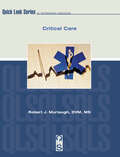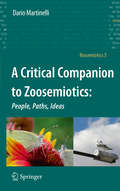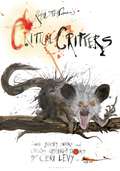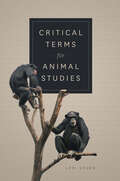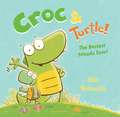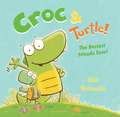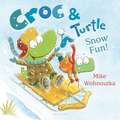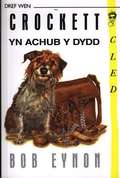- Table View
- List View
Cricket (UEB Contracted)
This is a picture of a cricket viewed from the top and facing towards the top of the page. There is a locator dot shown, which will be at the top left of the page when the image is the right way up. Just down the page, there is a silhouette of the cricket at approximately real size. At the top centre of the page are its feelers shown leading down to its head, with two eyes showing. Down the page, the cricket's thorax is shown, with three segmented legs, covered in small hairs, on either side. Further down the page is the abdomen and at the very bottom of the page are its reproductive organs extending downwards from the abdomen.
Cricket (UEB uncontracted)
This is a picture of a cricket viewed from the top and facing towards the top of the page. There is a locator dot shown, which will be at the top left of the page when the image is the right way up. Just down the page, there is a silhouette of the cricket at approximately real size. At the top centre of the page are its feelers shown leading down to its head, with two eyes showing. Down the page, the cricket's thorax is shown, with three segmented legs, covered in small hairs, on either side. Further down the page is the abdomen and at the very bottom of the page are its reproductive organs extending downwards from the abdomen.
Critical Animal And Media Studies: Communication For Nonhuman Animal Advocacy (PDF)
by Núria Almiron Matthew Cole Carrie P. FreemanThis book aims to put the speciesism debate and the treatment of non-human animals on the agenda of critical media studies and to put media studies on the agenda of animal ethics researchers. Contributors examine the convergence of media and animal ethics from theoretical, philosophical, discursive, social constructionist, and political economic perspectives. The book is divided into three sections: foundations, representation, and responsibility, outlining the different disciplinary approaches' application to media studies and covering how non-human animals, and the relationship between humans and non-humans, are represented by the mass media, concluding with suggestions for how the media, as a major producer of cultural norms and values related to non-human animals and how we treat them, might improve such representations.
Critical Animal and Media Studies: Communication for Nonhuman Animal Advocacy (Routledge Research in Cultural and Media Studies)
by Núria Almiron Matthew Cole Carrie P. FreemanThis book aims to put the speciesism debate and the treatment of non-human animals on the agenda of critical media studies and to put media studies on the agenda of animal ethics researchers. Contributors examine the convergence of media and animal ethics from theoretical, philosophical, discursive, social constructionist, and political economic perspectives. The book is divided into three sections: foundations, representation, and responsibility, outlining the different disciplinary approaches’ application to media studies and covering how non-human animals, and the relationship between humans and non-humans, are represented by the mass media, concluding with suggestions for how the media, as a major producer of cultural norms and values related to non-human animals and how we treat them, might improve such representations.
Critical Animal and Media Studies: Communication for Nonhuman Animal Advocacy (Routledge Research in Cultural and Media Studies)
by Núria Almiron Matthew Cole Carrie P. FreemanThis book aims to put the speciesism debate and the treatment of non-human animals on the agenda of critical media studies and to put media studies on the agenda of animal ethics researchers. Contributors examine the convergence of media and animal ethics from theoretical, philosophical, discursive, social constructionist, and political economic perspectives. The book is divided into three sections: foundations, representation, and responsibility, outlining the different disciplinary approaches’ application to media studies and covering how non-human animals, and the relationship between humans and non-humans, are represented by the mass media, concluding with suggestions for how the media, as a major producer of cultural norms and values related to non-human animals and how we treat them, might improve such representations.
Critical Care
by Robert MurtaughFocusing on the basic science behind critical injury and treatment, this book discusses fluid and electrolytes, critical care support, multi-systemic disorders and critical care diseases. Pathophysiologic mechanisms behind critical injury are combined with core clinical content so the user may develop effective clinical judgments and formulate guidelines for patient assessment, diagnosis and treatment planning. The book features a very clear, easy to understand acid/base balance discussion with over 200 original conceptual drawings that facilitate understanding and 200 multiple choice questions for comprehension.
Critical Care
by Robert MurtaughFocusing on the basic science behind critical injury and treatment, this book discusses fluid and electrolytes, critical care support, multi-systemic disorders and critical care diseases. Pathophysiologic mechanisms behind critical injury are combined with core clinical content so the user may develop effective clinical judgments and formulate guidelines for patient assessment, diagnosis and treatment planning. The book features a very clear, easy to understand acid/base balance discussion with over 200 original conceptual drawings that facilitate understanding and 200 multiple choice questions for comprehension.
Critical Care Management for Laboratory Mice and Rats
by F. Claire HankensonFor critical care of laboratory rodents, there is a scarcity of sources for comprehensive, feasible, and response-oriented information on clinical interventions specific to spontaneous and induced models of disease. With the more complex cases that need critical care management, many treatment approaches to veterinary emergencies cannot be applied
A Critical Companion to Zoosemiotics: People, Paths, Ideas (Biosemiotics #5)
by Dario MartinelliA critical companion of zoosemiotics is the first attempt to systematise the study of animal communication and signification through its most important and/or problematic terms and concepts, and its most representative scholars. It is a companion, in that it attempts to cover the entire range of key terms in the field, and it's critical, in that it aims not only to describe, but also to discuss, problematise and, in some cases, resolve, these terms.
Critical Critters
by Ralph Steadman Ceri LevyFollowing on from Extinct Boids and Nextinction, Critical Critters is the third in this epic trilogy of books dedicated to extinct and critically endangered animals from cartoonist Ralph Steadman and film-maker Ceri Levy - the GONZOVATIONISTS.Expect plenty more of what made the first two books so successful - unpredictable nonsense beasts, irreverent jokes, a diary-style record of the creative mayhem, and around 100 spectacular illustrations by Ralph of critically endangered mammals, insects, fish, lizards and trees – a stunning collection, with a serious conservation message.Ceri's humorous but meaningful message accompanied by Ralph's sensational paintings will satisfy art-lovers and conservationists alike.
Critical Critters
by Ralph Steadman Ceri LevyFollowing on from Extinct Boids and Nextinction, Critical Critters is the third in this epic trilogy of books dedicated to extinct and critically endangered animals from cartoonist Ralph Steadman and film-maker Ceri Levy - the GONZOVATIONISTS.Expect plenty more of what made the first two books so successful - unpredictable nonsense beasts, irreverent jokes, a diary-style record of the creative mayhem, and around 100 spectacular illustrations by Ralph of critically endangered mammals, insects, fish, lizards and trees – a stunning collection, with a serious conservation message.Ceri's humorous but meaningful message accompanied by Ralph's sensational paintings will satisfy art-lovers and conservationists alike.
A CRITICAL EXAMINATION OF THE POSITION OF MR. DARWIN'S WORK, "ON THE ORIGIN OF SPECIES,"
by Thomas Henry HuxleyA Critical Examination of the Position of Mr. Darwin's Work, "On the Origin of Species," in Relation to the Complete Theory of the Causes of the Phenomena of Organic Nature Lecture VI. (of VI.), "Lectures to Working Men", at the Museum of Practical Geology, 1863, on Darwin's Work: "Origin of Species"
Critical Insights on Colonial Modes of Seeing Cattle in India: Tracing the Pre-history of Green and White Revolutions (Asia in Transition #27)
by Himanshu UpadhyayaThis book traces the contours of the symbiotic relationship between crop cultivation and cattle rearing in India by reading against the grain of several official accounts from the late colonial period to the 1980s. It also skillfully unpacks the multiple cultural expressions that revolve around cattle in India and the wider subcontinent to show how this domestic animal has greatly impacted political discourses in South Asia from colonial times, into the postcolonial period. The author begins by demonstrating the dependence between the nomadic cattle breeder and the settled cultivator, at the nexus of land-livestock-agriculture, as indicated in the writings of Sir Albert Howard, who espoused some of the most sophisticated ideas on integration, holism, and mixed farming in an era when agricultural research was marked by increasing specialisation and compartmentalisation. The book springboards with the views of colonial experts who worked at imperial science institutions but passionately voiced dissenting opinions due to their emotional investment in the lives of Indian peasants, of whom Howard was a leading light. The book presents Howard and his contemporaries’ writings to then engage contemporary debates surrounding organic agriculture and climate change, tracing the path out of the treadmill of industrial agriculture and factory farming. In doing so, the book shows how, historically, animal rearing has been critically linked to livelihood strategies in the Indian subcontinent. At once a dispassionate reflection on the role played by cattle and water buffaloes in not just supporting farm operations in the agro-pastoral landscape, but also in contributing to millions of livelihoods in sustainable ways while fulfilling the animal protein in the Indian diet, the book presents contemporary lessons on development perspectives relating to sustainable and holistic agriculture. A rich and sweeping treatment of this aspect of environmental history in India that tackles the transformations prompted by the arrival of veterinary medicine, veterinary education and notions of scientific livestock management, the book is a rare read for historians, environmentalists, agriculturalists, development practitioners, and animal studies scholars with a particular interest in South Asia.
A Critical Psychology: Interpretation of the Personal World (Path in Psychology)
by Edmund V. SullivanIf the reader will excuse a brief anecdote from my own intellectual history, I would like to use it as an introduction to this book. In 1957, I was a sophomore at an undergraduate liberal arts college major ing in medieval history. This was the year that we were receiving our first introduction to courses in philosophy, and I took to this study with a passion. In pursuing philosophy, I discovered the area called "philosophical psychology," which was a Thomistic category of inquiry. For me, "philosophical psychology" meant a more intimate study of the soul (psyche), and I immediately concluded that psychology as a discipline must be about this pursuit. This philosophical interest led me to enroll in my first introductory psychology course. Our text for this course was the first edition of Ernest Hilgaard's Introduction to Psychology. My reasons for entering this course were anticipated in the introductory chapter of Hilgaard's book, where the discipline and its boundaries were discussed, and this introduction was to disabuse me of my original intention for enrolling in the course. I was to learn that, in the 20th century, people who called themselves psychologists were no longer interested in perennial philosophical questions about the human psyche or person. In fact, these philosophical questions were considered to be obscurantist and passe. Psychology was now the "scientific" study of human behavior. This definition of psychology by Hilgaard was by no means idiosyncratic to this introductory textbook.
Critical Terms for Animal Studies (Critical Terms)
by Lori GruenAnimal Studies is a rapidly growing interdisciplinary field devoted to examining, understanding, and critically evaluating the complex relationships between humans and other animals. Scholarship in Animal Studies draws on a variety of methodologies to explore these multi-faceted relationships in order to help us understand the ways in which other animals figure in our lives and we in theirs. Bringing together the work of a group of internationally distinguished scholars, the contribution in Critical Terms for Animal Studies offers distinct voices and diverse perspectives, exploring significant concepts and asking important questions. How do we take non-human animals seriously, not simply as metaphors for human endeavors, but as subjects themselves? What do we mean by anthropocentrism, captivity, empathy, sanctuary, and vulnerability, and what work do these and other critical terms do in Animal Studies? Sure to become an indispensable reference for the field, Critical Terms for Animal Studies not only provides a framework for thinking about animals as subjects of their own experiences, but also serves as a touchstone to help us think differently about our conceptions of what it means to be human, and the impact human activities have on the more than human world.
Critical Terms for Animal Studies (Critical Terms)
by Lori GruenAnimal Studies is a rapidly growing interdisciplinary field devoted to examining, understanding, and critically evaluating the complex relationships between humans and other animals. Scholarship in Animal Studies draws on a variety of methodologies to explore these multi-faceted relationships in order to help us understand the ways in which other animals figure in our lives and we in theirs. Bringing together the work of a group of internationally distinguished scholars, the contribution in Critical Terms for Animal Studies offers distinct voices and diverse perspectives, exploring significant concepts and asking important questions. How do we take non-human animals seriously, not simply as metaphors for human endeavors, but as subjects themselves? What do we mean by anthropocentrism, captivity, empathy, sanctuary, and vulnerability, and what work do these and other critical terms do in Animal Studies? Sure to become an indispensable reference for the field, Critical Terms for Animal Studies not only provides a framework for thinking about animals as subjects of their own experiences, but also serves as a touchstone to help us think differently about our conceptions of what it means to be human, and the impact human activities have on the more than human world.
Critical Terms for Animal Studies (Critical Terms)
by Lori GruenAnimal Studies is a rapidly growing interdisciplinary field devoted to examining, understanding, and critically evaluating the complex relationships between humans and other animals. Scholarship in Animal Studies draws on a variety of methodologies to explore these multi-faceted relationships in order to help us understand the ways in which other animals figure in our lives and we in theirs. Bringing together the work of a group of internationally distinguished scholars, the contribution in Critical Terms for Animal Studies offers distinct voices and diverse perspectives, exploring significant concepts and asking important questions. How do we take non-human animals seriously, not simply as metaphors for human endeavors, but as subjects themselves? What do we mean by anthropocentrism, captivity, empathy, sanctuary, and vulnerability, and what work do these and other critical terms do in Animal Studies? Sure to become an indispensable reference for the field, Critical Terms for Animal Studies not only provides a framework for thinking about animals as subjects of their own experiences, but also serves as a touchstone to help us think differently about our conceptions of what it means to be human, and the impact human activities have on the more than human world.
Critical Terms for Animal Studies (Critical Terms)
by Lori GruenAnimal Studies is a rapidly growing interdisciplinary field devoted to examining, understanding, and critically evaluating the complex relationships between humans and other animals. Scholarship in Animal Studies draws on a variety of methodologies to explore these multi-faceted relationships in order to help us understand the ways in which other animals figure in our lives and we in theirs. Bringing together the work of a group of internationally distinguished scholars, the contribution in Critical Terms for Animal Studies offers distinct voices and diverse perspectives, exploring significant concepts and asking important questions. How do we take non-human animals seriously, not simply as metaphors for human endeavors, but as subjects themselves? What do we mean by anthropocentrism, captivity, empathy, sanctuary, and vulnerability, and what work do these and other critical terms do in Animal Studies? Sure to become an indispensable reference for the field, Critical Terms for Animal Studies not only provides a framework for thinking about animals as subjects of their own experiences, but also serves as a touchstone to help us think differently about our conceptions of what it means to be human, and the impact human activities have on the more than human world.
Critical Terms for Animal Studies (Critical Terms)
by Lori GruenAnimal Studies is a rapidly growing interdisciplinary field devoted to examining, understanding, and critically evaluating the complex relationships between humans and other animals. Scholarship in Animal Studies draws on a variety of methodologies to explore these multi-faceted relationships in order to help us understand the ways in which other animals figure in our lives and we in theirs. Bringing together the work of a group of internationally distinguished scholars, the contribution in Critical Terms for Animal Studies offers distinct voices and diverse perspectives, exploring significant concepts and asking important questions. How do we take non-human animals seriously, not simply as metaphors for human endeavors, but as subjects themselves? What do we mean by anthropocentrism, captivity, empathy, sanctuary, and vulnerability, and what work do these and other critical terms do in Animal Studies? Sure to become an indispensable reference for the field, Critical Terms for Animal Studies not only provides a framework for thinking about animals as subjects of their own experiences, but also serves as a touchstone to help us think differently about our conceptions of what it means to be human, and the impact human activities have on the more than human world.
Critical Terms for Animal Studies (Critical Terms)
Animal Studies is a rapidly growing interdisciplinary field devoted to examining, understanding, and critically evaluating the complex relationships between humans and other animals. Scholarship in Animal Studies draws on a variety of methodologies to explore these multi-faceted relationships in order to help us understand the ways in which other animals figure in our lives and we in theirs. Bringing together the work of a group of internationally distinguished scholars, the contribution in Critical Terms for Animal Studies offers distinct voices and diverse perspectives, exploring significant concepts and asking important questions. How do we take non-human animals seriously, not simply as metaphors for human endeavors, but as subjects themselves? What do we mean by anthropocentrism, captivity, empathy, sanctuary, and vulnerability, and what work do these and other critical terms do in Animal Studies? Sure to become an indispensable reference for the field, Critical Terms for Animal Studies not only provides a framework for thinking about animals as subjects of their own experiences, but also serves as a touchstone to help us think differently about our conceptions of what it means to be human, and the impact human activities have on the more than human world.
Croc & Turtle
by Mike WohnoutkaFor fans of Penguin and Pinecone, this adorable new duo will warm your heart and tickle your funny bone.Meet Croc! He is the strongest and fastest crocodile around.Meet Turtle! He agrees that Croc is the strongest and fastest.But what happens when Elephant lifts that heavy rock with ease? And when Cheetah speeds on by? Croc and Turtle might not be the strongest or the fastest, but they're definitely the best at something even more important . . . Introducing an utterly charming new duo, this humorous and heartwarming adventure will delight readers of all ages.
Croc & Turtle
by Mike WohnoutkaFor fans of Penguin and Pinecone, this adorable new duo will warm your heart and tickle your funny bone.Meet Croc! He is the strongest and fastest crocodile around.Meet Turtle! He agrees that Croc is the strongest and fastest.But what happens when Elephant lifts that heavy rock with ease? And when Cheetah speeds on by? Croc and Turtle might not be the strongest or the fastest, but they're definitely the best at something even more important . . . Introducing an utterly charming new duo, this humorous and heartwarming adventure will delight readers of all ages.
Croc & Turtle: Snow Fun!
by Mike WohnoutkaCroc & Turtle may be different, but they're the best of friends! This adorable winter-themed story will warm your heart, and is perfect for fans of Penguin and Pinecone.Croc and Turtle are best friends! It's a wintry day, so Croc and Turtle are ready for snow fun! But Croc likes outside activities and Turtle likes inside activities. What happens when best friends have very different ideas of fun? In this new humorous and heartwarming adventure, Croc and Turtle navigate the ups and downs of friendship.
Croc & Turtle: Snow Fun!
by Mike WohnoutkaCroc & Turtle may be different, but they're the best of friends! This adorable winter-themed story will warm your heart, and is perfect for fans of Penguin and Pinecone.Croc and Turtle are best friends! It's a wintry day, so Croc and Turtle are ready for snow fun! But Croc likes outside activities and Turtle likes inside activities. What happens when best friends have very different ideas of fun? In this new humorous and heartwarming adventure, Croc and Turtle navigate the ups and downs of friendship.
Crockett yn Achub y Dydd (Cyfres Cled)
by Bob Eynon Roger JonesNofel i blant am athro sy'n symud o Lundain i ysgol yng nghefn gwlad Cymru gan obeithio cael bywyd hamddenol, ond roedd gan blant drws nesaf syniadau gwahanol. [A children's novel about a teacher from London moving to a rural school in Wales hoping for a quiet life, but his neighbours' children have different ideas.] *Datganiad hawlfraint Gwneir y copi hwn dan dermau Rheoliadau (Anabledd) Hawlfraint a Hawliau mewn Perfformiadau 2014 i'w ddefnyddio gan berson sy'n anabl o ran print yn unig. Oni chaniateir gan gyfraith, ni ellir ei gopïo ymhellach, na'i roi i unrhyw berson arall, heb ganiatâd.



